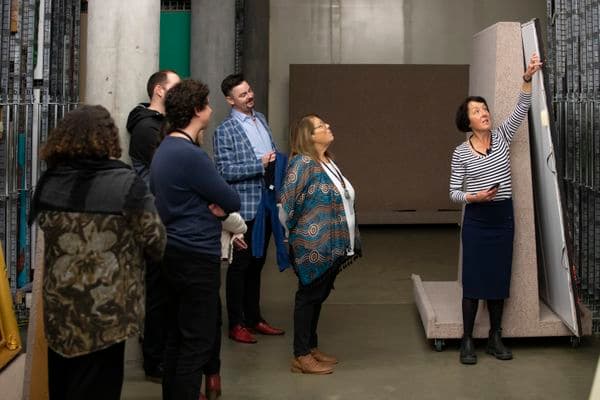Bali
Islands of the gods
13 Jun 2014 – 3 Aug 2014

Bali, Page from a Ramayana Kekawin manuscript, early 19th century, purchased 1990
About
The exhibition showcases a wide range of works—sculpture, textiles, paintings, architectural elements and ritual objects that will excite and surprise visitors, even those who have journeyed to the exotic island.
Sponsored by PricewaterhouseCoopers, Chandon and Coopers
Exhibition catalogue essay
The arts of the Indonesian island of Bali have captured and charmed visitors for centuries. The only large and vibrant Hindu community surviving outside India, Bali epitomises the colourful and creative impulses associated with the rich cycle of Hindu festivals, communal celebrations and daily domestic worship. The wide range of works—sculpture, textiles, paintings, architectural elements and ritual objects—in the Gallery's exhibition of Balinese art will excite and surprise visitors, even those who have journeyed to the exotic island.
Balinese fabric traditions are rich and varied, readily demonstrated in the examples drawn from the National Gallery of Australia's world famous collection of Indonesian textiles. Among the most admired are the geringsing, created only in one village in east Bali. Through double ikat, the most complex of techniques, both the warp and the weft threads are separately tied into the designs, which only become evident when interlaced during the weaving process.
The most striking of the handspun cotton geringsing (a term loosely translated as 'protection from illness') display scenes of praise and adoration akin to the bas relief stone sculptures on Hindu temples in Bali and on surviving remains from mediaeval Java. Other Balinese textiles are vibrantly coloured, with heroic figures, floral fantasies and dynamic religious symbols rendered in silk, sequins and gold and silver thread.
Painted hangings, hung in and around temples and shrines for temple and palace festivals, also draw their imagery from Hindu symbols and legends, most notably the tensions and battles in the Ramayana and Mahabharata. Included in the exhibition are two fine ider-ider, narrow valances illuminating scenes from the great Hindu epics that decorate the eaves of open air pavilions: one ider-ider from the collection of the late Professor Anthony Forge is over 17 metres long. Drawn from the Adiparwa, the first book of the Mahabharata, a recurring theme on the large squarish tabing, which hang as backdrops at temple rituals, is the creation of the universe from the Ocean of Milk as it is churned by opposing forces of gods and demons pulling on the great serpent.
The national collection includes three superb manuscripts with similar subject matter from the Mahabharata: the Adiparwa and the Smaradahana are formed from long rectangular palm leaves incised in breathtaking detail. The third comprises exquisite double-sided ink drawings on English laid paper dated 1811, the period of Raffles' brief governorship of the Indonesian archipelago. It illustrates the Ramayana, probably the best known of the Indian epics, with scenes of the distressed Sita in captivity on Ravana's island, the monkey general Hanuman carrying her ring back to her searching husband Rama, and the monkey army constructing the causeway across from India to the island to mount the successful confrontation and rescue.
The Balinese sculptures in the exhibition are brilliantly painted and range from overtly Hindu images, such as the god Vishnu mounted on his vehicle the giant Garuda bird, to ferocious guardian creatures whose destructive powers balance the benevolence of other deities to maintain cosmic order. Often composed of elements of real animals, birds and fish, such demonic creatures feature bulging eyes, menacing fangs and dangerous claws.
Drawn entirely from the Gallery's important and diverse collection of Balinese art, the Bali: Island of the gods exhibition will be accompanied by an informative illustrated catalogue.
Robyn Maxwell
Senior Curator, Asian Art
Text sourced from Artonview, Issue No. 77 Autumn 2014, p. 16–17.











